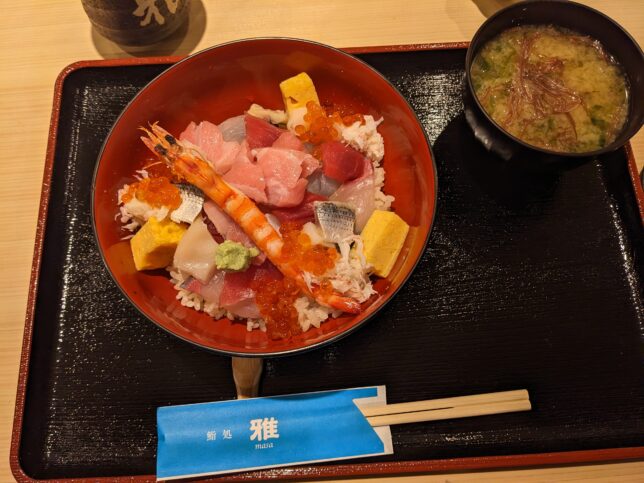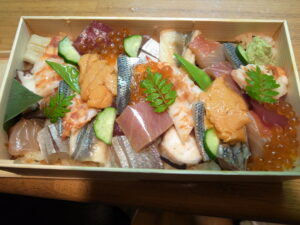The other day I went to a recently relocated sushi shop behind Suitengu Shrine in Ningyōchō, Sushi Masa. My wife and I had been to the former place, located one block away, several years ago and found it to be okay but a bit on the expensive side. But after going past the new location nearly every day for the past couple of months and seeing their lunch menu outside, I finally decided to go.
I don’t know why, but for some reason when I go out for basic sushi for lunch I usually order chirashi sushi rather than nigiri. For those not familiar with chirashi sushi, it is a bowl of sushi rice topped with various neta (ingredients), most of which are also used to top nigiri sushi. The name comes from the verb chirasu, meaning to scatter or strew, such as with cherry blossoms after a big wind storm. I ordered Masa’s ¥2,000 bara (rose) chirashi, which was quite good, with plenty of akami and chūtoro maguro, some crab, and lots of ikura, making for a very colorful dish, a nod to it being “rose” chirashi (imagine multi-colored rose petals scattered about).

Chirashi sushi is excellent for picnics or hanami parties; it’s easy to carry and eat, and the vinegared rice prevents spoilage. Back at the beginning of the corona pandemic, many of our local sushi shops’ only business was selling takeout chirashi sushi. The best—and at ¥10,000 for the top version the most expensive—was Sugita Sushi’s chirashi sushi. I think my wife and I tried takeout chirashi from a half dozen or so sushi shops I had not previously been to. It was a cheap way to sample a lot of different versions while at the same time supporting local businesses when they needed it most.


While Sushi Masa’s bara chirashi was good, and filling, it didn’t rate up there with Sugita’s version or of Kizushi’s chirashi which has something like 25 or more different neta (toppings). Still, I will be going back.